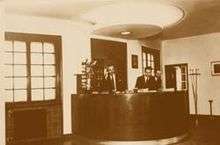Đurđe S. Ninković
Djurdje S. Ninković (1888 - November 1940) was a prominent businessman and hotelier in Belgrade, Kingdom of Yugoslavia, in the 1930s. At that time Belgrade had very few hotels [1][2] and he was a pioneer in establishing functional style affordable hotels specifically aimed at business people[3] who were travelling to Belgrade from other parts of Yugoslavia mainly by railways in increasing numbers.
Hotels
In 1930 he commissioned the well known architect Branislav Kojić, who was a proponent of the traditional Serbian national style but also incorporating principles of modernism,[1] to design a new hotel opposite the main Belgrade Glavna railway station and the central Post Office building. The blandly named hotel Pošta (the Post office hotel) on Sava Square, with some 35 guest rooms and a restaurant,[4] was completed and opened in 1931.[1]
In 1937 hotelier Ninković together with his son-in-law, architect Ivan Savković, commenced the project to build, what was at the time, one of the biggest hotels in Belgrade.[3] On the opposite side of Sava Square architect Savković, who was a proponent of the modernist architectural style, made a utilitarian and functional design for hotel Astoria which was opened for guests in April 1938 [3] with some 80 guest rooms, a large restaurant and bar.
.jpg)
Through the 1930s hotelier Ninković was very much involved in all aspects of the hotel industry in Belgrade [5] being a governor of the newly established hospitality and hotel studies high school and, on the recommendation of the Chamber of Commerce and Trades in Belgrade, he was appointed by the Ministry of Justice to serve as an honorary judge (počasni sudija) of the Trade Court (Trgovacki sud) in Belgrade. He was awarded the Order of the Yugoslav Crown in 1940 [5] for services to the hotel industry.

Legacy
The concept of the functional and affordable hotel for increasing travel needs of business people really took off in Yugoslavia after the Second World War through increase in rail travel for trade and business and then in the 1960s and 1970s with the advent of air travel as well, showing that hotelier Ninković had correctly anticipated the development of the affordable business hotel concept. Both, Astoria and Pošta, are still operating today as hotels. It is a testimony to their strategic position that they are still two of the closest hotels to the main entrance of the Belgrade Glavna railway station. However, the area around the station, known as Savamala, deteriorated in character after the Second World War and became run down as private property was confiscated and enterprising individuals and businesses were replaced by communist state owned concerns. It is only recently since 2001, with the advent of post-communist private capital, that major buildings have been privatised and renovated and the Savamala area is re-establishing its respectability.
Hotelier Ninković's grandson, also named Djurdje Ninković, has been engaged in long term campaigning and litigation for restitution of hotelier Ninković's property which was forcibly nationalized by the Communist Government of Yugoslavia in 1948.[5]
References
- 1 2 3 Article on hotel Pošta in Journal of Architectural history Nasledje 2006, No. 7, pages 219-224
- ↑ The Hotel Posta brochure from 2008 (link below) states that in 1936 there were only 23 hotels in Belgrade
- 1 2 3 Article on hotel Astoria in Journal of Architectural history Nasledje 2012
- ↑ http://www.hoteli-srbije.co.rs/hoteli-beograda/posta.htm Hotel Posta profile on “Hotels of Serbia” web-site
- 1 2 3 Article on Hotel Astoria - legal case study in Vox Iuris, Journal of legal theory and practice, 2009, No. 3-4
External links
- Hotel Posta brochure from 2008 detailing some historical facts about hotels in Belgrade
- Article about hotel Posta in 2011 including its history and the renovations which are being undertaken since 2011 (English)
- Article in English on the history of Hotel Posta from Nasledje (Heritage) (No 7 pp 219-224, 2006, by Simonida Rkalovic) historical magazine about architectural history
- Article in English on the history of Hotel Astoria from Nasledje (Heritage) (No 13 pp 103-109, 2012) historical magazine
- Article on history of hotel Astoria and the owner Djura Ninkovic from Politika newspaper in Serbia (09/03/2009)
- Article on Hotel Astoria - Legal Case Study, Vox Iuris (Journal of legal theory and application), No 2-3, December 2009
- Article in Journal of Architectural history Nasledje 2006, No. 7, pages 219-224
- Article in Journal of Architectural history Nasledje 2012
- Article from Radio Television Serbia on hotel Astoria
- Article from Novosti newspaper, Serbia(10 december 2011) on hotel Astoria and its history
- Article from Novosti newspaper Serbia (7 september 2011) which mentions Dj. Ninkovic and hotel Astoria
- Article from Politika newspaper Serbia on history of hotel Astoria and the owner Dj. Ninkovic